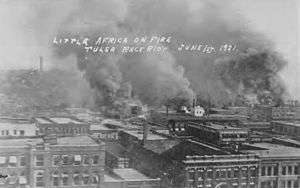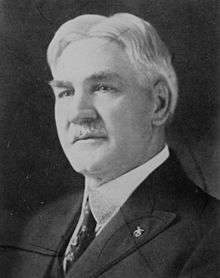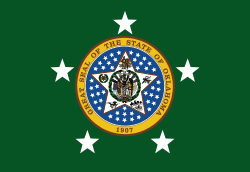James B. A. Robertson
| James Brooks Ayers Robertson | |
|---|---|
 Official photo of Governor James B. A. Robertson | |
| 4th Governor of Oklahoma | |
|
In office January 13, 1919 – January 8, 1923 | |
| Lieutenant | Martin E. Trapp |
| Preceded by | Robert L. Williams |
| Succeeded by | John C. Walton |
| Personal details | |
| Born |
March 15, 1871 Keokuk County, Iowa |
| Died |
March 7, 1938 (aged 66) Oklahoma City, Oklahoma |
| Nationality | American |
| Political party | Democratic |
| Spouse(s) | Isabelle Butler Robertson |
| Profession | Teacher, Lawyer, Judge |
| Religion | Methodism |
James Brooks Ayers Robertson (March 15, 1871 – March 7, 1938), sometimes called J. B. A. Robertson, was an American lawyer, judge and the fourth governor of Oklahoma. Robertson was appointed by the state's first governor, Charles N. Haskell to serve as a district judge.
Passing a bar exam at the age of 21, Robertson became one of the most resourceful trial lawyers and legal counselors in the Oklahoma and Indian territories.[1] His gubernatorial term was marked by Oklahoma's ratification of the Eighteenth Amendment and Nineteenth Amendment to the United States Constitution, the Tulsa Race Riot, and scandals. He also served as Grand Sire (now known as Sovereign Grand Master) of the Sovereign Grand Lodge of the Independent Order of Odd Fellows from 1915 to 1916 [2]
Robertson died in 1938 from cancer and is buried in Chandler, Oklahoma.
Early life
James Brooks Ayers Robertson was born in Keokuk County, Iowa, on March 15, 1871, to a father of the same name from Pennsylvania and Clara Robertson from Ohio. In the early 1850s, both of Robertson’s parents moved to Iowa, where Robertson's father served as a volunteer soldier in the Union army during the American Civil War. Robertson’s Iowa upbringing would instill in him firm progressive attitudes.[1]
The fifth child born to a family of six sons and five daughters, Robertson was educated in the Iowa public school system. Robertson became a licensed teacher when he was only 16. While teaching, he was privately studying law and the legal system, and he passed the Iowa bar exam in 1892 at the age of 21. The following year, Robertson moved to Chandler in Oklahoma Territory.
Chandler had been opened via Land Run on September 28, 1891, and the county seat of Lincoln County needed municipal leaders. Seizing the opportunity, Robertson set up teaching and practicing law in the fledgling city. His popularity throughout Lincoln County won him the office of county attorney, the chief legal officer of the county. While in Chandler, Robertson met Olive Stubblefield, whom he would marry in 1898. They had two children: Olive Frances and a boy named after his father, grandfather, and great-grandfather, James Brooks Ayers Robertson IV (referred to as James Brooks Ayers Robertson Jr.).
Robertson became known as one of the most resourceful trial lawyers and legal counselors in the Oklahoma and Indian territories.[1] In 1906, Robertson became a partner in Hoffman and Robertson, a law firm he practiced with for the next two years.
Oklahoma was admitted to the Union as a state in 1907. The first governor of Oklahoma, Charles N. Haskell, named him to the District Court of the Tenth Judicial District of Oklahoma in 1908.[3] The job required Robertson to move from Chandler to Oklahoma City, where he spent the rest of his years.
Before his appointment to the court, Robertson played an active role in the Oklahoma and national Democratic parties. Robertson was a prominent and influential Democrat in Oklahoma. He offered to help any Democratic candidate in any way he could. On a trip with Governor Haskell to Denver, Robertson represented the Oklahoma Democratic Party. Robertson zealously supported the Democratic nomination of William Jennings Bryan for the presidency.[1]
Robertson continued to serve as a judge until Governor Charles Haskell, now his friend, chose not to seek re-election in 1910. Resigning his seat on the court to run for governor, Robertson ultimately withdrew from the Democratic primary to support Lee Cruce, who went on to win the party's nomination and serve as the second governor of Oklahoma.
Not satisfied with returning to private life, Robertson ran for Congress. The 1910 Federal Census had resulted in Oklahoma being granted three seats in the United States Congress, tempting him to run in the Democratic primary for his district's seat, but he failed to receive the party’s nomination.
Robertson returned to private law practice in Oklahoma City. However, in 1914, Governor Cruce, like Haskell before him, decided not to run for a second term. Once again, Robertson tried to get the Democratic nomination for governor, but the popular former Chief Justice of Oklahoma Robert L. Williams won it instead.
Robertson’s beloved wife Olive died on June 1, 1914, leaving Robertson to raise their two children.
Gubernatorial campaign
Finally, Robertson’s persistence paid off. In 1918, seeking the Democratic gubernatorial nomination for the third consecutive time, Robertson defeated the colorful and popular William H. Murray.
The popularity of Governor Charles N. Haskell had strengthened the already strong position of the Oklahoma Democratic Party in the state. However, in 1910 a new party had appeared in Oklahoma politics, the Socialist Party of America. For the first time in Oklahoma’s history, the two major parties were joined by a third party in the contest for governor. Robertson faced Republican Horace G. McKeever, and Socialist Patrick Nagle. A major factor in the election was the infamous Green Corn Rebellion of 1917, which the Socialist Party had helped cause, making them appear to be unpatriotic.[1] Robertson won in a landslide, and other state Democratic candidates won considerable majorities in both the Oklahoma House of Representatives and Oklahoma Senate.
Governor of Oklahoma
Robertson was inaugurated on January 13, 1919, as Oklahoma's fourth governor. He was soon faced with two national issues: nationwide prohibition and women's suffrage.
- Under Governor Haskell, Oklahoma had already adopted a firm policy against alcohol. Robertson worked to build on Haskell's policies, leading Oklahoma to overwhelmingly ratify the Eighteenth Amendment, which was added to the United States Constitution on January 16, 1919.
- Written with progressivism in mind, Oklahoma’s constitution enshrined the right to vote for all races and both women and men. Robertson called a special session that led to the state's ratification of the Nineteenth Amendment, which became part of the national Constitution on August 18, 1920.[3]
Among Robertson's accomplishments was the creation of the office of Oklahoma Commissioner of Pensions. He also established cooperative marketing agencies to serve the state’s farmers, who had been hit hard by agricultural overproduction caused by the needs of World War I. Robertson also ushered a bill through the legislature providing for the addition of over 1,300 miles of paved roads, more than had been paved in all three previous administrations.
Partly using his experience as a teacher, Robertson also focused on improving Oklahoma’s school system. First, he worked to change how colleges operated in Oklahoma. Before his administration, colleges had been supervised by the State Board of Education under the State School Superintendent. Under Robertson, the governor's power over colleges increased with the creation of a Board of State Regents, its members appointed by the governor, to oversee all institutions of higher education. In his budgets, Robertson also funded improvements in teacher certification, higher standards for school performance and accreditation, consolidation of many rural schools, and institution of a subsidized textbook program. He also wanted more money for schools with apparent inadequacies, but this measure was rejected by the legislature.[1]
Robertson also had setbacks. His administration's work on Oklahoma’s highways was a vast improvement to what the state had had but was nowhere near what was needed. He failed to get voter support for $50 million in necessary highway improvements. The Bank Guaranty Program Governor Haskell had instituted collapsed following Oklahoma’s recession in 1920, resulting in the closure of many state banks. Although the Socialist Party was no longer a political threat, it advocated strikes. In 1919, telephone workers struck in Drumright, Oklahoma, and eastern Oklahoma experienced a massive strike of coal miners. Governor Robertson, in his position as Commander-in-Chief, declared martial law in these regions.

Robertson’s administration saw the worst race relations in Oklahoma’s history. To help confront this issue, Robertson created a commission on racial relations composed of both white and black members, but it did little to improve things. In the early morning hours of June 1, 1921, the Black areas of Tulsa was looted and burned by white rioters.[4] During the 16 hours of rioting, over 800 people were admitted to local hospitals with injuries, an estimated 10,000 were left homeless, 35 city blocks with 1,256 residences were destroyed by fire, and $1.8 million in property damage (nearly $17 million after adjustment for inflation). Robertson finally regained control by once again declaring martial law and sending in the Oklahoma National Guard to police the area and end the chaos. The riot affected Oklahoma for generations to come, promoting nativism, creating fear of the radical left, and allowing the growth of the Ku Klux Klan for the first time in Oklahoma.

To make matters worse politically, under Robertson’s guard the Democrats lost complete control of the Oklahoma Legislature. Following the 1920 midterm elections, the Republicans gained control of the Oklahoma House of Representatives. Also, the U.S. presidency shifted from Democrat Woodrow Wilson to Republican Warren G. Harding.[3] Oklahoma also lost its Democratic U.S. senator, Thomas Gore, who was replaced by John W. Harreld, the first Republican from Oklahoma to serve in the United States Senate. Robertson was left with a divided legislature, and he could not steer the legislature to pass his proposed policies for the remaining two years of his term.
Scandals would haunt Robertson’s remaining time as governor. Disputes between the Republican House and Democratic Senate resulted in the House’s investigation of the executive branch, most notably Robertson himself.[3] As in the case of Governor Lee Cruce before him, the House came within only one vote of impeaching Robertson.
Harder times were still ahead for Robertson when in 1921 the House adjourned without voting on appropriation bills. This forced Robertson to operate the government on deficit spending until he called a special session of the legislature to resolve the issue. Robertson also faced considerable opposition from the Republican Corporation Commissioner Campbell Russell, who exposed what the Republicans believed to be a scandal in Robertson’s handling of pardons and paroles.[3]
With the inauguration of John C. Walton as the fifth governor, Robertson left office on January 8, 1923.
Later life, arrest and death
As a private citizen, Robertson resumed practicing law. Following his leave from office, Robertson, along with some 30 current and former state officials, was charged with bribery in a bank scandal.[3] On the evening of March 22, 1922, Robertson submitted to arrested in Okmulgee County, Oklahoma. Earlier that day a grand jury which investigated the failure of state banks in Okmulgee country, named Robertson and Fred G. Dennis, former state banking commissioner in an indictment.[5] He was acquitted, but the episode hurt his political career. He ran for governor again, for Oklahoma Supreme Court justice, and for U.S. senator, but he never held another political office, appointed or elected.
Robertson died of cancer on March 7, 1938 in Oklahoma City. He was buried in his adoptive hometown of Chandler in Oak Park Cemetery.
State of the State Speeches
- "First State of the State Speech" (PDF). (117 KB)
- "Second State of the State Speech" (PDF). (178 KB)
- "Third State of the State Speech" (PDF). (798 KB)
- "Extraordinary Address to the Legislature" (PDF). (64.6 KB)
References
- 1 2 3 4 5 6 "State biography of James Robertson" (PDF). (57.2 KB)
- ↑ Template:P.684-685 Journal of Proceedings of the Sovereign Grand Lodge, I.O.O.F.
- 1 2 3 4 5 6 O'Dell, Larry. Robertson, James Brooks Ayers (1871-1938), Encyclopedia of Oklahoma History and Culture. (accessed June 30, 2013)
- ↑
- ↑ "OKLAHOMA GOVERNOR PUT UNDER ARREST; J.B. Robertson Is Accused of Accepting Bribes in Connection With Bank Failures." - New York Times, March 23, 1922
Sources
- "State biography of James Robertson" (PDF). (57.2 KB)
| Political offices | ||
|---|---|---|
| Preceded by Robert L. Williams |
Governor of Oklahoma 1919–1923 |
Succeeded by John C. Walton |
